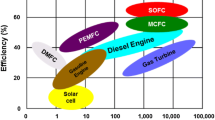Abstract
Particle processing is a key to using solid particles in fuel cell applications. Selectivity with regard to reactivity, impurities, etc. is an important feature and the treatment of particle surfaces could greatly impact the performance of direct carbon fuel cells. Solid fuel particles will become increasingly important in the future. Present energy conversion systems for solid fuels are too inefficient. New energy conversion systems for solid fuels with higher energy conversion efficiencies are possible. Fuel cell technology is a key technology in these new conversion systems. The direct carbon fuel cell (DCFC) operates on carbon particles obtained from a variety of solid fuel feedstocks. The DCFC is the only fuel cell designed to directly oxidize carbon particles in a special anode chamber. The particles are generally graphite structure with high purity. The electrolyte used is the high temperature solid oxide, molten carbonate, or hydroxide electrolyte. Since a pure stream of CO2 is produced, the stream can easily be sequestered and disposed. Pure carbon dioxide produced as a by-product would also have a market in many industries. A well-defined technology roadmap identifying key research and development (R&D) issues is necessary to provide a framework for the development of these systems and to prevent entrenchment in inherently inefficient technologies. This review paper describes the direct carbon fuel cell and its system, how it works, the developmental status, the characteristics of the carbon particles needed, and the research and development issues for the technology.





Similar content being viewed by others
References
Williams MC, Horita T, Yamaji K, Yokokawa H (2007) An application of solid particles in fuel cell technology. KONA Powder and Particle Journal 25:153–161
Zecevic (2003) Electrochemistry of direct carbon fuel cell based on metal hydroxide electrolyte. Presentation at US DOE DCFC symposium, Pittsburgh, PA
Fuel cell handbook, 7th edn. US DOE NETL, November 2004
Williams MC (2007) Exergetic studies of intermediate temperature electrolytes. Japan Society for Promotion of Science Report
Heywood B (2006) Direct carbon conversion: directions of power. SRI Special Report, Institute of Physics and IOP Publishing
Cooper JF (2005) LLNL status, presentation at Direct Carbon Fuel Cell Workshop, Fuel Cell Seminar
Cooper JF, Cherepy NJ, Krueger R, Fiet KJ, Jankowski AF (2005) Direct conversion of carbon fuels in a molten carbonate fuel cell. J Electrochem Soc 152(1):80–87
Cooper JF (2001) Turning carbon directly into electricity. Science and Technology Review, pp 4–12
Patton R (2003) SARA status, presented at US DOE DCFC symposium, Pittsburgh, PA
Tao T (2005) CellTech status, presentation at Direct Carbon Fuel Cell Workshop, Fuel Cell Seminar
Steinberger M (2003) An innovative highly efficient combined cycle fossil and biomass fuel power generation and hydrogen production plant with zero CO2 emission. US DOE DCFC symposium, Pittsburgh, PA
Parekh R (2003) Overview of coal beneficiation. Presented at US DOE DCFC symposium, Pittsburgh, PA
Steinberg M, Cooper JF, Cherepy N (2002) High efficiency direct carbon and hydrogen fuel cells for fossil fuel power generation. UCRL-10-146774, Lawrence Livermore National Laboratory, Livermore, CA (January 2002) and Fuel Cell Technology, Topical Conf. Proc., AIChE Meeting, New Orleans, pp 148–63
Williams M (2005) US DOE stationary fuel cell program. In Fuel cell seminar extended abstracts
Williams MC (2003) NETL overview. Presentation at US DOE DCFC symposium, Pittsburgh, PA
Rastler D (2005) DCFC, presentation at Direct Carbon Fuel Cell Workshop, Fuel Cell Seminar
Horita T, Sakai N, Kawada T, Yokokawa H, Doikya M (1995) An investigation of anodes for direct-oxidation of carbon in solid oxide fuel cells. J Electrochem Soc 142(8):2621–2624
Selman R (2003) DCFT research needs, presentation at US DOE DCFC symposium, Pittsburgh, PA
Munnings C, Kulkarni A, Giddey S, Badwal SPS (2014) Biomass to power conversion in a direct carbon fuel cell. Int J Hydrog Energy 39(23):12377–12385
Rady AC, Giddey S, Kulkarni A, Badwal SPS, Bhattacharya S (2014) Degradation mechanism in a direct carbon fuel cell operated with demineralised Brown coal. Electrochim Acta 143:278–290
Giddey S, Badwal SPS, Kulkarni A, Munnings C (2012) A comprehensive review of direct carbon fuel cell technology. Prog Energy Combust Sci 38(3):360–399
Rady AC, Giddey S, Kulkarni A, Badwal SPS, Bhattacharya S (2012) Degradation mechanism in a direct carbon fuel cell operated with demineralised brown coal. Electrochim Acta 143:278–290
HyungKuk J, Eom J, Lee JK, Choi H, Lim T-H, Song R-H, Lee J (2014) Durable power performance of a direct ash-free coal fuel cell. Electrochim Acta 115:511
Kulkarni A, Ciacchi FT, Giddey S, Munnings C, Badwal SPS, Kimpton JA, Fini D (2012) Mixed ionic electronic conducting perovskite anode for direct carbon fuel cells. Int J Hydrog Energy 37(24):19092–19102
Author information
Authors and Affiliations
Corresponding author
Ethics declarations
Conflict of Interest
The authors declare that they have no conflict of interest.
Rights and permissions
About this article
Cite this article
Behling, N.H., Managi, S. & Williams, M.C. Updated Look at the DCFC: the Fuel Cell Technology Using Solid Carbon as the Fuel. Mining, Metallurgy & Exploration 36, 181–187 (2019). https://doi.org/10.1007/s42461-018-0022-x
Received:
Accepted:
Published:
Issue Date:
DOI: https://doi.org/10.1007/s42461-018-0022-x




